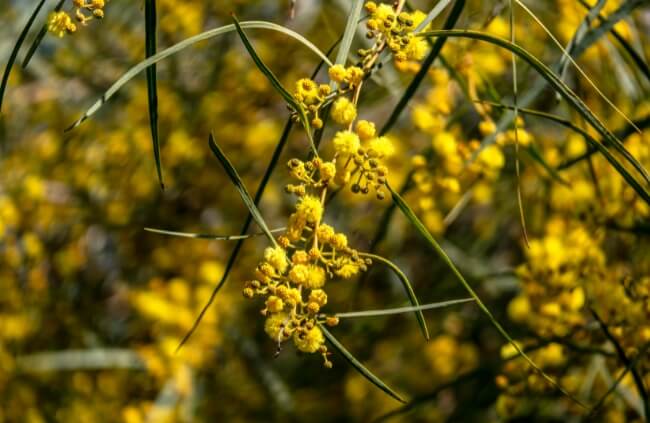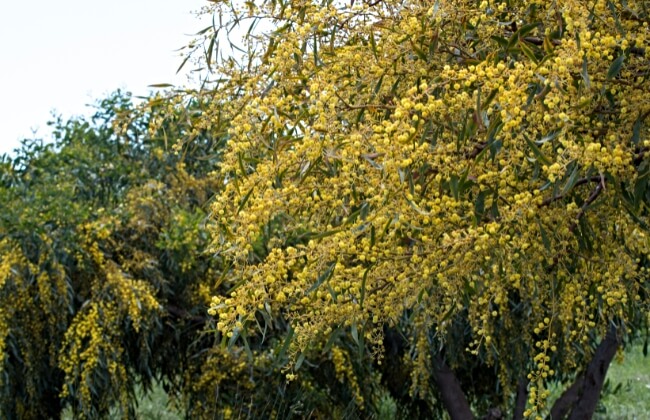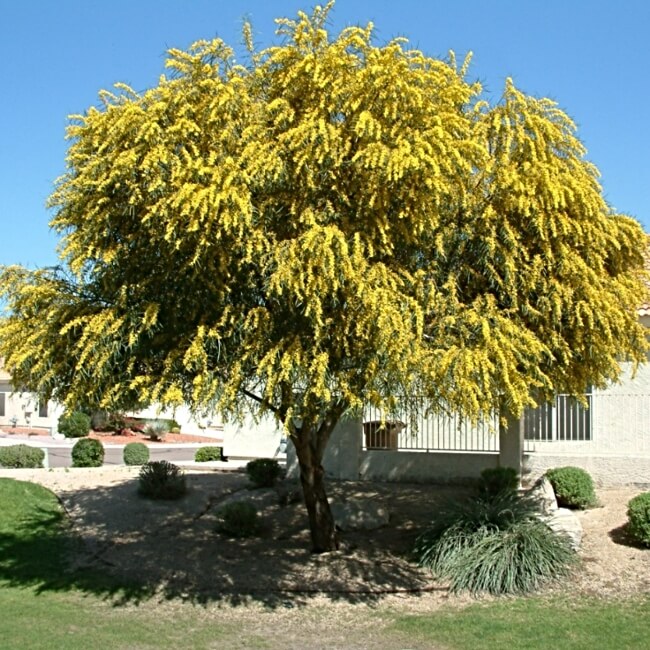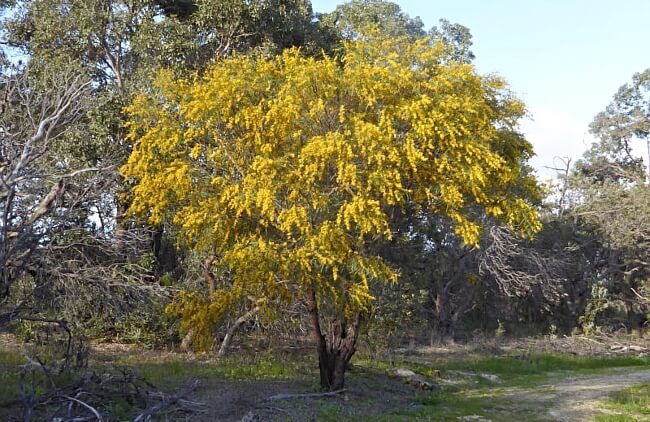In the right place, golden wreath wattle (Acacia saligna) can be a fantastically beautiful tree. In the wrong place, it presents gardens and nature with several problems.
This glowing wattle, native to southeastern Australia, is one of the most popular garden wattles in the country, but also around the world. Its acid-yellow blooms have buckets of character and flowers when garden pollinators need it most.
We will take the time here to share how to grow Acacia saligna, but do be aware that this spectacular and well-proportioned tree comes with several warnings from local governments about its weed potential, and can potentially threaten less adaptable local Acacia species.
More...

Family: | Fabaceae |
|---|---|
Genus: | Acacia |
Species: | A. saligna |
Common names: | Southwestern Australia |
Origin: | Golden Wreath Wattle, Coojong, Western Australian Golden Wattle, Blue-leafed Wattle |
Location: | Outdoor |
Type: | Small tree |
Growth: | 8m tall |
Sun requirements: | Full sun |
Foliage colour: | Glaucous |
Flower colour: | Yellow |
Flowering: | Late winter and early spring |
Edible parts: | Edible flowers and seeds |
Maintenance level: | Low |
Poisonous for pets: | Toxic to cats and dogs |
Introducing Acacia saligna
Short, short-lived, and short-tempered are probably the easiest ways to define Acacia saligna.
Why? Well, they grow to a maximum height of 8m, but rarely reach more than 4m tall; in cooler more temperature parts of Australia, they generally only live for about twenty years; and the weeping branches that characterise it are easily snapped in winds, creating organic but agitated forms that are far from typical of the genus.
Despite that list of flaws, they are undeniably beautiful trees, with canopies becoming covered in bright golden-yellow blooms in late winter, and delicately papery foliage that rustles in the slightest wind.
In different parts of Australia, there is conflicting advice about where, or if, to plant golden wreath wattle trees. In southwestern Australia, they are commonly occurring native plants, but they have been spread by gardeners, councils and park planting schemes all across the South Coast, where they now outcompete some native species.

What is Acacia saligna ‘Prostrate’?
One cultivated type exists in addition to Acacia saligna. It is simply called ‘Prostrate’, because it grows outwards without any hint of an upright stem, reaching about 1m tall, but with a spread of 3-4m.
Its flower forms, foliage and bark are the same as the upright naturally occurring species, but it makes for a very straightforward ground cover plant, which has a longer lifespan than other acacias. However, it is also considered a weed in most parts of the country and will spread if not managed.
The prostrate variety is also commonly called Acacia saligna ‘Springtime Cascade’.
Golden Wreath Wattle’s Natural Habitat
Acacia saligna is native to southwestern Western Australia, predominantly in coastal parts of the region to the south of Perth. It can grow in forests and open flatlands, preferring dry conditions surrounded by grasses or understory shrubs and meadow, but it will grow on mountain slopes, rocky outcrops and sand (its ability to stabilise sand dunes meant it was planted extensively in South Africa, where it has had a devastating effect on local ecology.
Common Uses for Acacia saligna
Acacia saligna is a useful bushtucker food and one of many edible Acacia species. Both the flowers and seeds of golden wreath wattle (also called Coojong, Western Australian golden wattle and blue-leafed wattle) are edible.
The most common traditional and contemporary use for the bright-yellow pom-pom flowers, which are sweet and nectar-rich, is to brew them into a tea or steep them in cool water.
But they can also be fried into fritters or used as decorations on cakes or for a subtle sweetness in salads (pick the petals off individually rather than adding whole flowers).


Get Your Free Guide:
Master Growing Australian Natives eBook
A Must Have Complete Guide for Every Australian Garden
Get Your Free Guide:
Master Growing Australian Natives eBook
A Must Have Complete Guide for Every Australian Garden
Many acacia seeds (wattle seeds) are edible, but not all. Thankfully Acacia saligna has edible seeds, which are easily harvested from the hanging seed pods, and used as a dried bean similar to coffee, or dried and ground as a spice to enrich savoury and sweet dishes.
Managing Acacia saligna
Before we talk about how to grow Acacia saligna, it is important to share details on how to manage, remove and control these frustrating but beautiful plants. Because they are weeds in most parts of the country.
If you live in Perth or the southwest, grow it happily and celebrate a little bit of hyper-local flora in your own garden, but gardeners in Sydney and South Australia should be particularly aware that golden wreath wattle is an invasive weed in those areas, and classed as such by local government.
Find out more about the Government of South Australia’s advice on Acacia saligna.

Why is Acacia saligna seen as a weed?
In South Africa and the UK, Acacia saligna is banned from sale due to its invasive traits, which are just as vigorous in cooler temperature climates as they are in our own.
Planted in the right place, golden wreath wattle is a wonderful ornamental tree, but its weed potential is undeniable. The seeds are very viable, with most germinating on contact with soil.
Once germinated it takes about a year to establish feeding roots, but grows very rapidly after that. Fire control and root removal can often trigger seed germination, as the seeds germinate even more reliably after fire or soil disturbance.
Prevent Acacia saligna from Self-Seeding
It isn’t practical to deadhead or remove seed pods from fully grown trees, even at just 4m tall. The seed pods and flowers will be out of reach. However, when the seed pods are ripe, rather than leaving them on the tree, vigorously shaking the main trunk will cause most to fall to the ground, where you can collect them, rather than risking their spread by birds.
Prostrate golden wreath wattle is easier to manage, as you can simply remove seed pods as they form.
Identifying Young Acacia saligna Trees
It is virtually impossible to guarantee the identification of this species at the seedling stage, but there are some distinguishing characteristics that set it apart from other Acacia seedlings.
If you have an Acacia saligna, or one in a neighbouring garden, learning to identify the trees at the seedling stage will help with long-term management. The small mimosa leaves of most acacias aren’t present in mature Acacia saligna.
Instead, they have lanceolate leaves. At the seedling stage, the first leaves will be lanceolate – very similar to the mature tree in colour and texture, with a leading central show.
However, at the tip of some leaves, tiny mimosa-like leaves will also form. This creates an unusually textured, and unusually structured seedling. This form is rare, but not unique to Acacia saligna.
Removing Mature Acacia saligna Trees
In South Australia, the specific advice is to remove Acacia saligna where it is present, even as mature trees. This should be done by felling the tree and chemically treating the stump so it doesn’t resprout.
In nearly all cases we would advise against chemical herbicides, but there are a few other options as digging the tree up risks promoting germination of undisturbed seeds around its base, and burning the stump can also trigger germination if undisturbed seeds are exposed to the smoke.
Obviously for younger trees, or if you are willing to manage any resulting seedlings, digging the stump and as many roots as possible is the best and most environmentally conscious way to remove a mature golden wreath wattle.
How to Grow Acacia saligna
If you happen to live within the native range of Acacia saligna (Western Australia, south of Perth) then we’ve got tips for growing, propagating and caring for these beautifully bright, vigorous, but manageably sized, trees.
Throughout the guide, there will be twists and turns, as is the habit of golden wreath wattle, because there are several ways to plant, prune and care for these trees, depending on the types you grow, and the appearance you’re after.
Ideal Conditions for Acacia saligna
Full sun, poor soil, limited irrigation. In short, that’s what golden wreath wattle needs, and it’s also the easiest way to plant it, but it can be grown in other conditions, and has benefits for the garden when planted in poor conditions too.
Soil & Drainage
Acacia saligna is happy in nearly all soils, but it doesn’t like very alkaline soil. Any pH, from 4-8 should be fine. Soil conditions and texture are even more variable than pH because, while golden wreath wattle will grow in open flat planes it will also grow on sand dunes, rocky outcrops, and incredibly dense, compacted, dry earth too.
Part of the appeal of this Acacia species is its ability to fix nitrogen and break up poor soil. Because of its rapid growth, it is often used for this purpose in agricultural settings, where it is planted for a few years then cut back and tilled.
Light & Temperature
Golden wreath wattle rarely reaches its 8m potential. The only time it will is with excessive irrigation and limited sunlight. The coupling of those conditions can cause water shoots that grow upwards, rather than the weeping branches it is known for.
In full sun, the soil will be drier, and it will focus on developing a deep tap root, while the branches and foliage hang down to ground level.
Shelter
Shelter is important for all acacias, and Coojong in particular. Its weeping habit means it centre of gravity is usually lower, so less susceptible to rocking, but it also means the main branches are weighed down.
High winds cause regular snapping branches. Prostrate golden wreath wattle doesn’t have this problem, and clever pruning will also reduce the strain, and improve the shape of Acacia saligna.
How to Propagate Acacia saligna
Plants propagated from seeds and cuttings are possible ways to extend your stock of Acacia saligna. Golden wreath wattle seeds germinate readily in a variety of conditions, and cuttings are simple to take – though definitely work better with rooting gel.
Below, we’ll look at how to take cuttings from gold leaf wattle and how to sow its seeds for optimum results.

Source: Happy Tree Guys
Propagating Acacia saligna from Seeds
Growing Acacia saligna is easier than you could possibly imagine. The seeds can be planted once dried, or while fresh, and they will root into nearly any growing medium.
Ideally, they should be grown in a well-drained seed compost, but any coir compost, sieved peat-free compost or horticultural sand mixed with topsoil will work fine.
Fill a seed tray or pots with compost, and plant seeds 10cm apart. Keep the soil on the drier side, but mist or water gently once a week to stop it drying out completely. Once germinated and large enough to handle, you can prick out, or grow your Acacia seeds in individual pots until ready to plant.
Propagating Acacia saligna from Cuttings
The large leaves of Acacia saligna are the only real barrier to cuttings because they use (and lose) so much moisture during the process. Remember to trim each leaf back by at least half its length and your cuttings should take well.
The best time to take cuttings is late summer or early autumn.
Acacia saligna cutting process:
- Start by filling a pot with a fine coir compost, with about 10-20% mixed in (Tip: we add a very small sprinkle of Osmocote slow-release granules here – they won’t affect the cuttings, but provide support for early root development once leaves establish).
- Using clean secateurs, take a 15cm section of semi-hard Acacia saligna stem, cutting just below a node.
- Dip the cut end in rooting gel, and insert it immediately into the potting mixture.
- Water the soil well, and place the cutting in a humid space like a cold frame, out of direct sun.
- Once watered and positioned, use clean scissors to trim each leaf by half to prevent moisture loss.
- Cuttings usually take about a month to take root, so keep the soil slightly moist during that time, and plant out when the roots are well-developed.
Caring for Acacia saligna
There are only two cultivation notes for Acacia saligna after it is planted and rooted. They focus on how much and how often to water, and how to prune the tree – primarily a visual concern, but one that can extend the lives of these short-lived trees.
Watering Acacia saligna
Watering golden wreath wattle is more important than you might think. Cooler regions or shaded spots can trigger more rapid growth, and more regular watering or rainfall can lead to rapid growth that is far less dense than typical examples of this species.
The danger of this is the fire risk posed by lower-density materials, which catch and burn quickly. Water deeply but only during very prolonged droughts. Acacia saligna is a drought-tolerant tree and will recover from drought.
Pruning Acacia saligna
The weeping habit of Acacia saligna can be beautiful in the right space, but in most gardens, it will take up too much space, and lead to branch snapping. Cutting weeping branches back every few years to create a denser canopy at the top of the tree will help to control its growth and width, and means you can grow these trees in surprisingly small spaces.
Common Acacia saligna Pests and Diseases
Xylella fastidiosa is the most common fungal problem suffered by Acacia saligna, but there are others – particularly leaf diseases, characterised by brown patches surrounded by yellow faded borders.
These fungal diseases are common, and not generally damaging to mature trees, but will kill saplings or seedlings. They should be managed and controlled by removing leaves.
One particular fungus that has actively been used in the control of Acacia saligna is Uromycladium tepperianum, or Acacia rust fungus. It will infect most Acacia species native to Australia, so should be removed, but in other parts of the world is deliberately introduced to kill off invasive acacias.
Most pests are weevils or beetles which channel into the bark and timber of the golden wreath wattle as well as feeding on foliage. They are well predated and managed by birds, and rarely cause lasting damage to mature trees.
Acacia saligna Frequently Asked Questions

Source: Friends of Queens Park Bushland
What is the use of Acacia saligna?
Golden wreath wattle’s main uses are in soil conservation, but as a food source and material, it is also beneficial for tanning materials, firewood and a fast-growing source of raw-garden materials (it makes an excellent mulch for other plants if coppiced).
What is the lifespan of Acacia saligna?
Acacia saligna typically lives for around 40 years in nature in its native range, but in gardens, rarely lives beyond 20. The limited lifespan can be off-putting to gardeners, but its main use is in soil regeneration, anchoring loose soils, and nitrogen-fixing others.
What are the side effects of Acacia?
Acacia, including golden wreath wattle, has several minor side effects including bloating, nausea, gas and loose stool. These side effects are reported regardless of its preparation, including as a food, a coffee substitute or a medicinal supplement.
Is Acacia good for gut health?
Despite some adverse side effects, Acacia is often advised as a prebiotic, encouraging more active movement of the digestive system, which can increase positive gut bacteria significantly. The role of prebiotics is to serve as an energy source for probiotics.
What is the common name for Acacia saligna?
The common name for Acacia saligna is the golden wreath wattle, coojong, or Western Australian Golden Wattle. The third is less common, but probably the most important to remember as it is the only part of the country where it is advisable to plant it.
Add a Splash of Golden Blooms in Your Outdoor Space with Acacia saligna
Acacia saligna is a stunning plant. There’s no way to deny that. But, it is also a potential pest, damaging local ecosystems outside of its native range, and potentially supporting the spread of disease to other native acacias outside of southern Western Australia.
Where possible, grow and care for golden wreath wattle (Acacia saligna) within its native range. If you do, you’ll be rewarded by one of the loveliest native trees there is, and can hopefully appreciate the unique position that puts you in, to grow and own this spectacular piece of native flora.
Published on October 6, 2023 by Nathan Schwartz
Last Updated on April 15, 2024




